Nursing in Chronic Illness | Report
VerifiedAdded on 2022/08/21
|8
|2222
|20
AI Summary
Contribute Materials
Your contribution can guide someone’s learning journey. Share your
documents today.
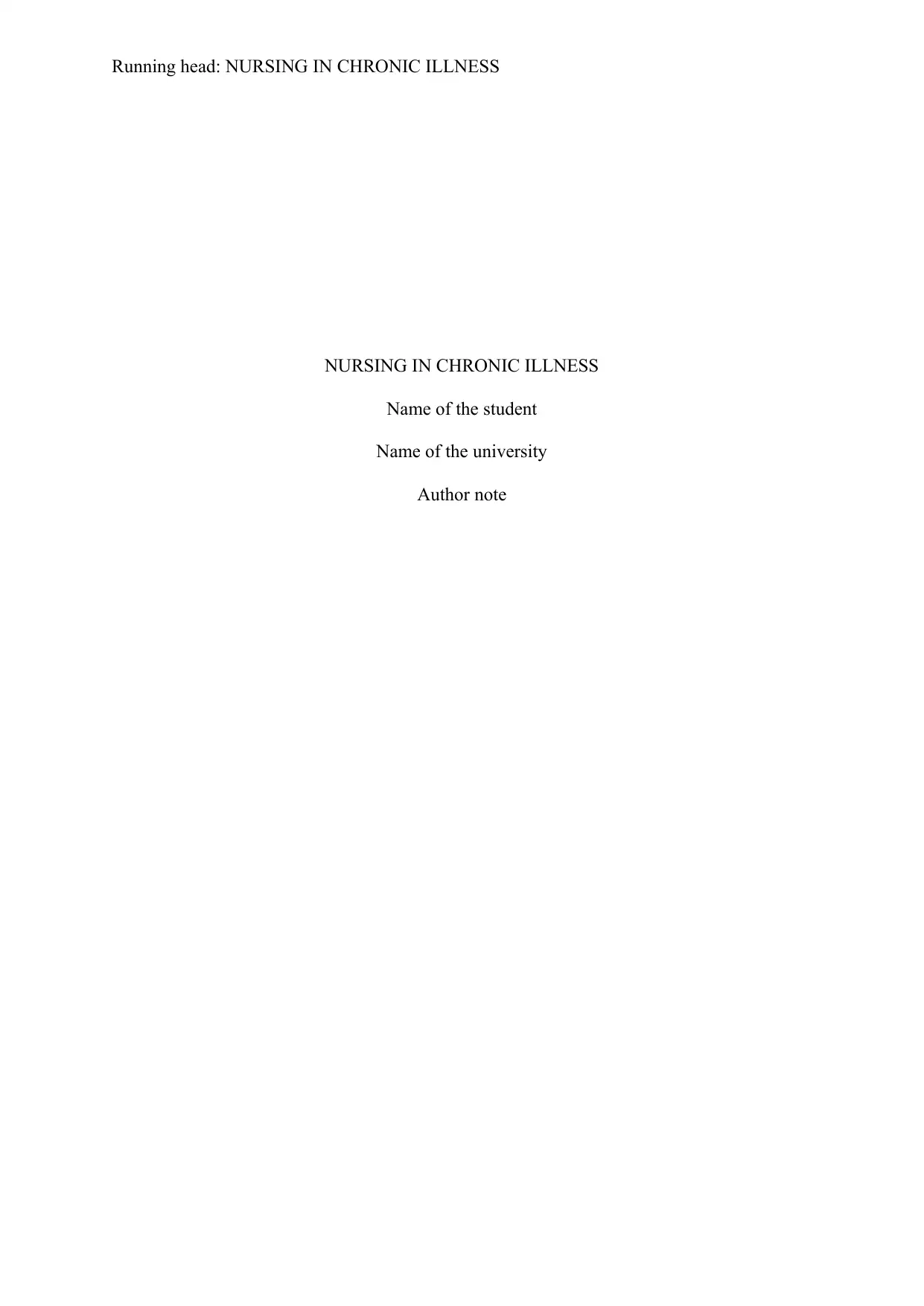
Running head: NURSING IN CHRONIC ILLNESS
NURSING IN CHRONIC ILLNESS
Name of the student
Name of the university
Author note
NURSING IN CHRONIC ILLNESS
Name of the student
Name of the university
Author note
Secure Best Marks with AI Grader
Need help grading? Try our AI Grader for instant feedback on your assignments.
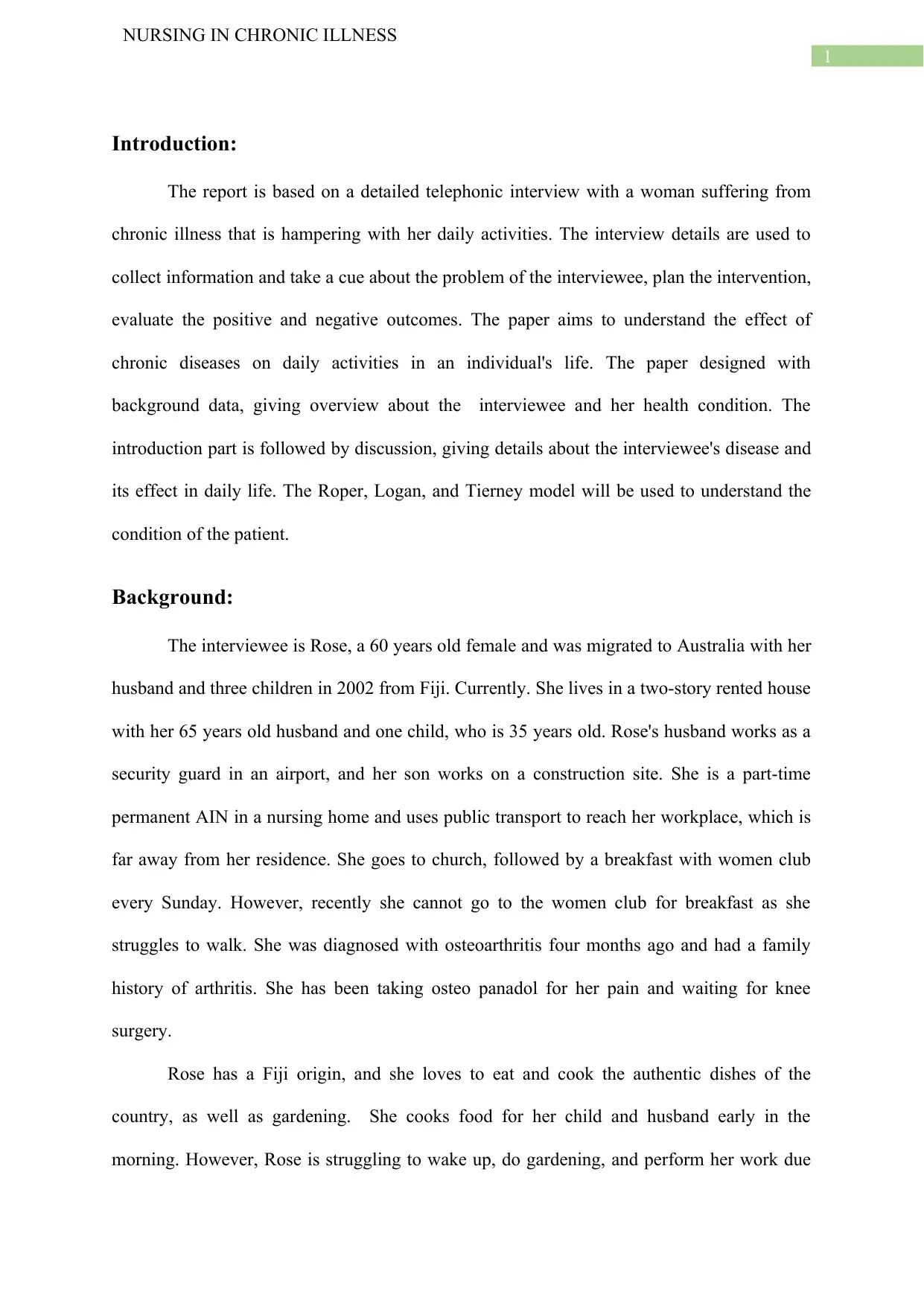
1
NURSING IN CHRONIC ILLNESS
Introduction:
The report is based on a detailed telephonic interview with a woman suffering from
chronic illness that is hampering with her daily activities. The interview details are used to
collect information and take a cue about the problem of the interviewee, plan the intervention,
evaluate the positive and negative outcomes. The paper aims to understand the effect of
chronic diseases on daily activities in an individual's life. The paper designed with
background data, giving overview about the interviewee and her health condition. The
introduction part is followed by discussion, giving details about the interviewee's disease and
its effect in daily life. The Roper, Logan, and Tierney model will be used to understand the
condition of the patient.
Background:
The interviewee is Rose, a 60 years old female and was migrated to Australia with her
husband and three children in 2002 from Fiji. Currently. She lives in a two-story rented house
with her 65 years old husband and one child, who is 35 years old. Rose's husband works as a
security guard in an airport, and her son works on a construction site. She is a part-time
permanent AIN in a nursing home and uses public transport to reach her workplace, which is
far away from her residence. She goes to church, followed by a breakfast with women club
every Sunday. However, recently she cannot go to the women club for breakfast as she
struggles to walk. She was diagnosed with osteoarthritis four months ago and had a family
history of arthritis. She has been taking osteo panadol for her pain and waiting for knee
surgery.
Rose has a Fiji origin, and she loves to eat and cook the authentic dishes of the
country, as well as gardening. She cooks food for her child and husband early in the
morning. However, Rose is struggling to wake up, do gardening, and perform her work due
NURSING IN CHRONIC ILLNESS
Introduction:
The report is based on a detailed telephonic interview with a woman suffering from
chronic illness that is hampering with her daily activities. The interview details are used to
collect information and take a cue about the problem of the interviewee, plan the intervention,
evaluate the positive and negative outcomes. The paper aims to understand the effect of
chronic diseases on daily activities in an individual's life. The paper designed with
background data, giving overview about the interviewee and her health condition. The
introduction part is followed by discussion, giving details about the interviewee's disease and
its effect in daily life. The Roper, Logan, and Tierney model will be used to understand the
condition of the patient.
Background:
The interviewee is Rose, a 60 years old female and was migrated to Australia with her
husband and three children in 2002 from Fiji. Currently. She lives in a two-story rented house
with her 65 years old husband and one child, who is 35 years old. Rose's husband works as a
security guard in an airport, and her son works on a construction site. She is a part-time
permanent AIN in a nursing home and uses public transport to reach her workplace, which is
far away from her residence. She goes to church, followed by a breakfast with women club
every Sunday. However, recently she cannot go to the women club for breakfast as she
struggles to walk. She was diagnosed with osteoarthritis four months ago and had a family
history of arthritis. She has been taking osteo panadol for her pain and waiting for knee
surgery.
Rose has a Fiji origin, and she loves to eat and cook the authentic dishes of the
country, as well as gardening. She cooks food for her child and husband early in the
morning. However, Rose is struggling to wake up, do gardening, and perform her work due
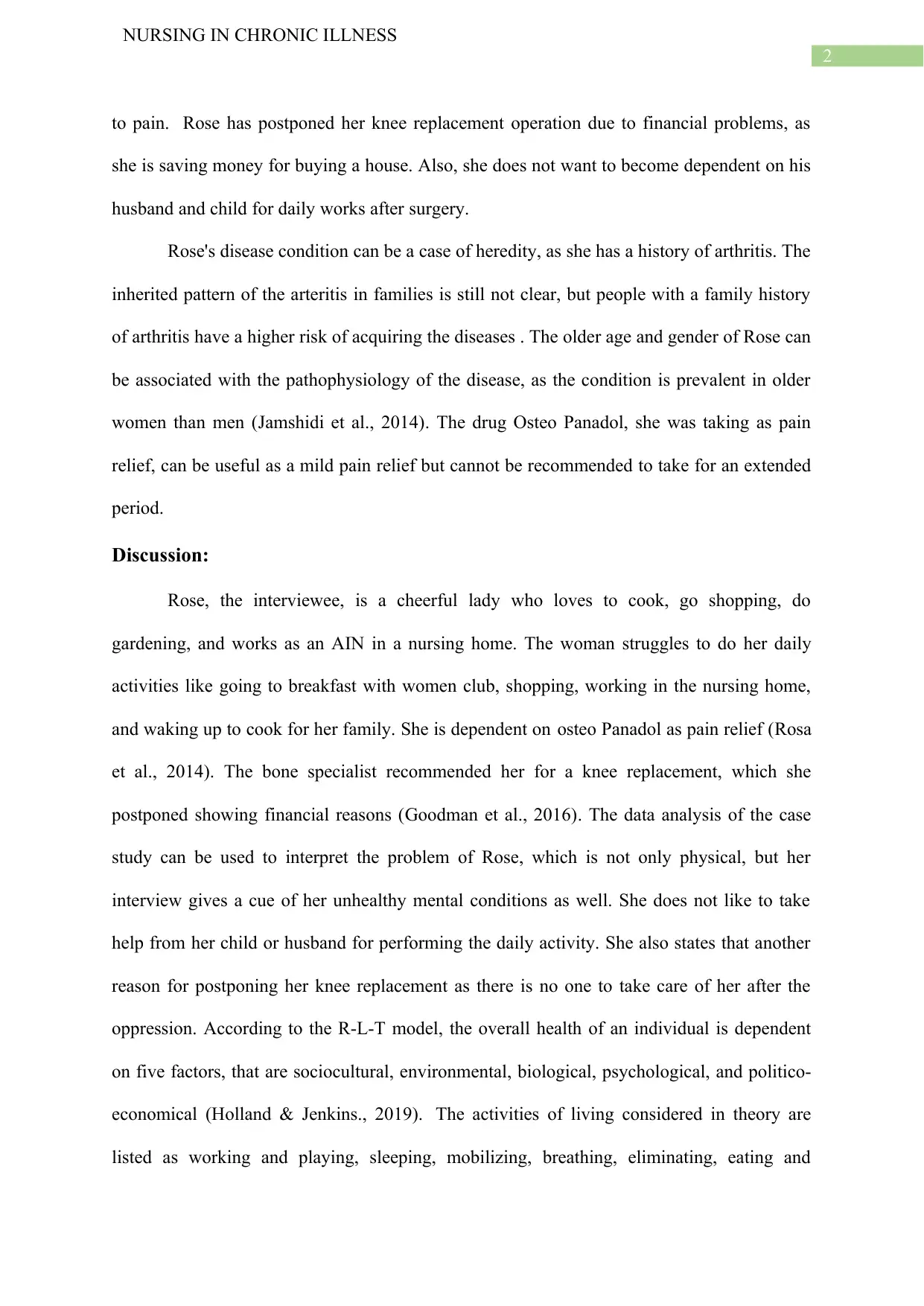
2
NURSING IN CHRONIC ILLNESS
to pain. Rose has postponed her knee replacement operation due to financial problems, as
she is saving money for buying a house. Also, she does not want to become dependent on his
husband and child for daily works after surgery.
Rose's disease condition can be a case of heredity, as she has a history of arthritis. The
inherited pattern of the arteritis in families is still not clear, but people with a family history
of arthritis have a higher risk of acquiring the diseases . The older age and gender of Rose can
be associated with the pathophysiology of the disease, as the condition is prevalent in older
women than men (Jamshidi et al., 2014). The drug Osteo Panadol, she was taking as pain
relief, can be useful as a mild pain relief but cannot be recommended to take for an extended
period.
Discussion:
Rose, the interviewee, is a cheerful lady who loves to cook, go shopping, do
gardening, and works as an AIN in a nursing home. The woman struggles to do her daily
activities like going to breakfast with women club, shopping, working in the nursing home,
and waking up to cook for her family. She is dependent on osteo Panadol as pain relief (Rosa
et al., 2014). The bone specialist recommended her for a knee replacement, which she
postponed showing financial reasons (Goodman et al., 2016). The data analysis of the case
study can be used to interpret the problem of Rose, which is not only physical, but her
interview gives a cue of her unhealthy mental conditions as well. She does not like to take
help from her child or husband for performing the daily activity. She also states that another
reason for postponing her knee replacement as there is no one to take care of her after the
oppression. According to the R-L-T model, the overall health of an individual is dependent
on five factors, that are sociocultural, environmental, biological, psychological, and politico-
economical (Holland & Jenkins., 2019). The activities of living considered in theory are
listed as working and playing, sleeping, mobilizing, breathing, eliminating, eating and
NURSING IN CHRONIC ILLNESS
to pain. Rose has postponed her knee replacement operation due to financial problems, as
she is saving money for buying a house. Also, she does not want to become dependent on his
husband and child for daily works after surgery.
Rose's disease condition can be a case of heredity, as she has a history of arthritis. The
inherited pattern of the arteritis in families is still not clear, but people with a family history
of arthritis have a higher risk of acquiring the diseases . The older age and gender of Rose can
be associated with the pathophysiology of the disease, as the condition is prevalent in older
women than men (Jamshidi et al., 2014). The drug Osteo Panadol, she was taking as pain
relief, can be useful as a mild pain relief but cannot be recommended to take for an extended
period.
Discussion:
Rose, the interviewee, is a cheerful lady who loves to cook, go shopping, do
gardening, and works as an AIN in a nursing home. The woman struggles to do her daily
activities like going to breakfast with women club, shopping, working in the nursing home,
and waking up to cook for her family. She is dependent on osteo Panadol as pain relief (Rosa
et al., 2014). The bone specialist recommended her for a knee replacement, which she
postponed showing financial reasons (Goodman et al., 2016). The data analysis of the case
study can be used to interpret the problem of Rose, which is not only physical, but her
interview gives a cue of her unhealthy mental conditions as well. She does not like to take
help from her child or husband for performing the daily activity. She also states that another
reason for postponing her knee replacement as there is no one to take care of her after the
oppression. According to the R-L-T model, the overall health of an individual is dependent
on five factors, that are sociocultural, environmental, biological, psychological, and politico-
economical (Holland & Jenkins., 2019). The activities of living considered in theory are
listed as working and playing, sleeping, mobilizing, breathing, eliminating, eating and
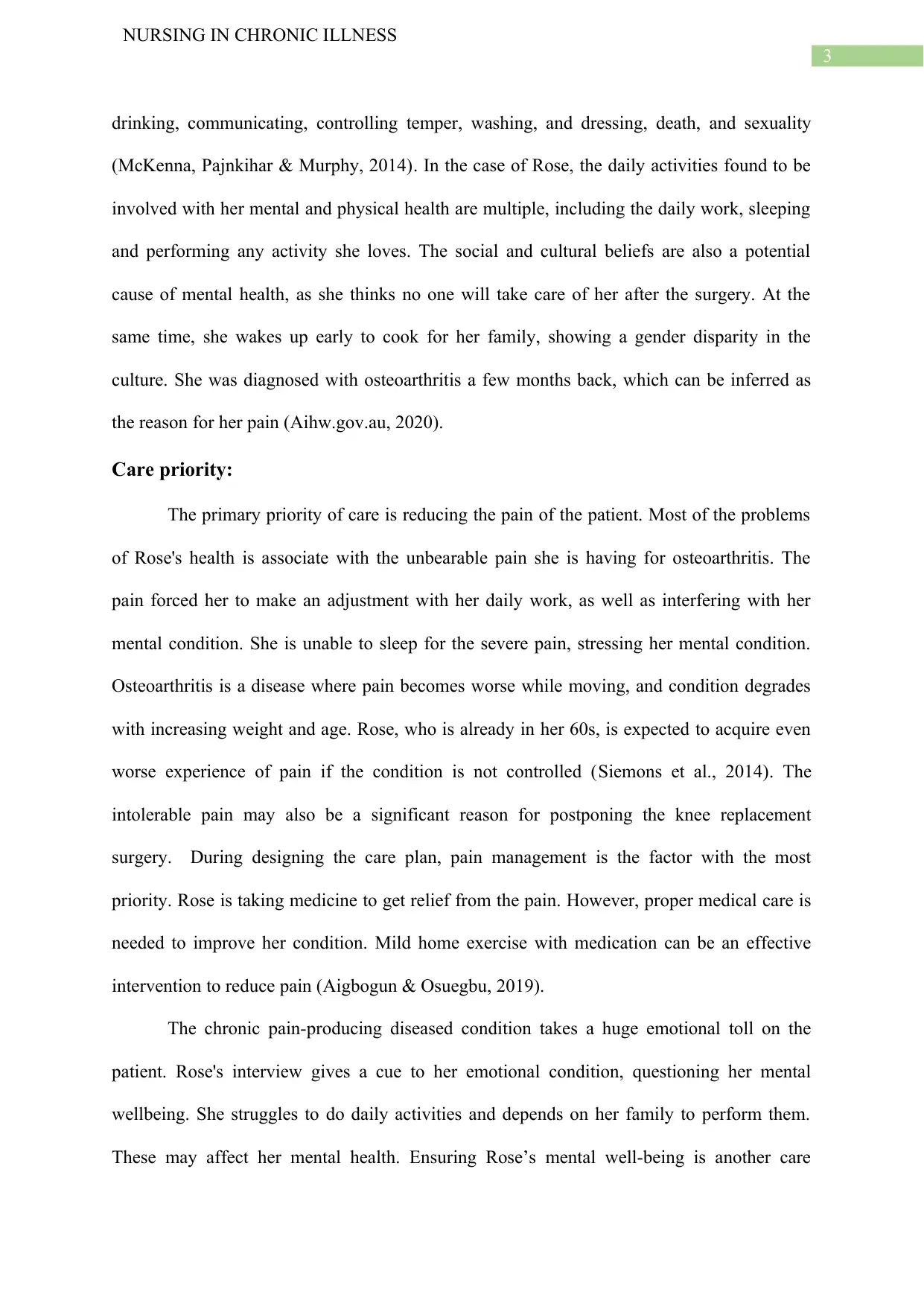
3
NURSING IN CHRONIC ILLNESS
drinking, communicating, controlling temper, washing, and dressing, death, and sexuality
(McKenna, Pajnkihar & Murphy, 2014). In the case of Rose, the daily activities found to be
involved with her mental and physical health are multiple, including the daily work, sleeping
and performing any activity she loves. The social and cultural beliefs are also a potential
cause of mental health, as she thinks no one will take care of her after the surgery. At the
same time, she wakes up early to cook for her family, showing a gender disparity in the
culture. She was diagnosed with osteoarthritis a few months back, which can be inferred as
the reason for her pain (Aihw.gov.au, 2020).
Care priority:
The primary priority of care is reducing the pain of the patient. Most of the problems
of Rose's health is associate with the unbearable pain she is having for osteoarthritis. The
pain forced her to make an adjustment with her daily work, as well as interfering with her
mental condition. She is unable to sleep for the severe pain, stressing her mental condition.
Osteoarthritis is a disease where pain becomes worse while moving, and condition degrades
with increasing weight and age. Rose, who is already in her 60s, is expected to acquire even
worse experience of pain if the condition is not controlled (Siemons et al., 2014). The
intolerable pain may also be a significant reason for postponing the knee replacement
surgery. During designing the care plan, pain management is the factor with the most
priority. Rose is taking medicine to get relief from the pain. However, proper medical care is
needed to improve her condition. Mild home exercise with medication can be an effective
intervention to reduce pain (Aigbogun & Osuegbu, 2019).
The chronic pain-producing diseased condition takes a huge emotional toll on the
patient. Rose's interview gives a cue to her emotional condition, questioning her mental
wellbeing. She struggles to do daily activities and depends on her family to perform them.
These may affect her mental health. Ensuring Rose’s mental well-being is another care
NURSING IN CHRONIC ILLNESS
drinking, communicating, controlling temper, washing, and dressing, death, and sexuality
(McKenna, Pajnkihar & Murphy, 2014). In the case of Rose, the daily activities found to be
involved with her mental and physical health are multiple, including the daily work, sleeping
and performing any activity she loves. The social and cultural beliefs are also a potential
cause of mental health, as she thinks no one will take care of her after the surgery. At the
same time, she wakes up early to cook for her family, showing a gender disparity in the
culture. She was diagnosed with osteoarthritis a few months back, which can be inferred as
the reason for her pain (Aihw.gov.au, 2020).
Care priority:
The primary priority of care is reducing the pain of the patient. Most of the problems
of Rose's health is associate with the unbearable pain she is having for osteoarthritis. The
pain forced her to make an adjustment with her daily work, as well as interfering with her
mental condition. She is unable to sleep for the severe pain, stressing her mental condition.
Osteoarthritis is a disease where pain becomes worse while moving, and condition degrades
with increasing weight and age. Rose, who is already in her 60s, is expected to acquire even
worse experience of pain if the condition is not controlled (Siemons et al., 2014). The
intolerable pain may also be a significant reason for postponing the knee replacement
surgery. During designing the care plan, pain management is the factor with the most
priority. Rose is taking medicine to get relief from the pain. However, proper medical care is
needed to improve her condition. Mild home exercise with medication can be an effective
intervention to reduce pain (Aigbogun & Osuegbu, 2019).
The chronic pain-producing diseased condition takes a huge emotional toll on the
patient. Rose's interview gives a cue to her emotional condition, questioning her mental
wellbeing. She struggles to do daily activities and depends on her family to perform them.
These may affect her mental health. Ensuring Rose’s mental well-being is another care
Secure Best Marks with AI Grader
Need help grading? Try our AI Grader for instant feedback on your assignments.
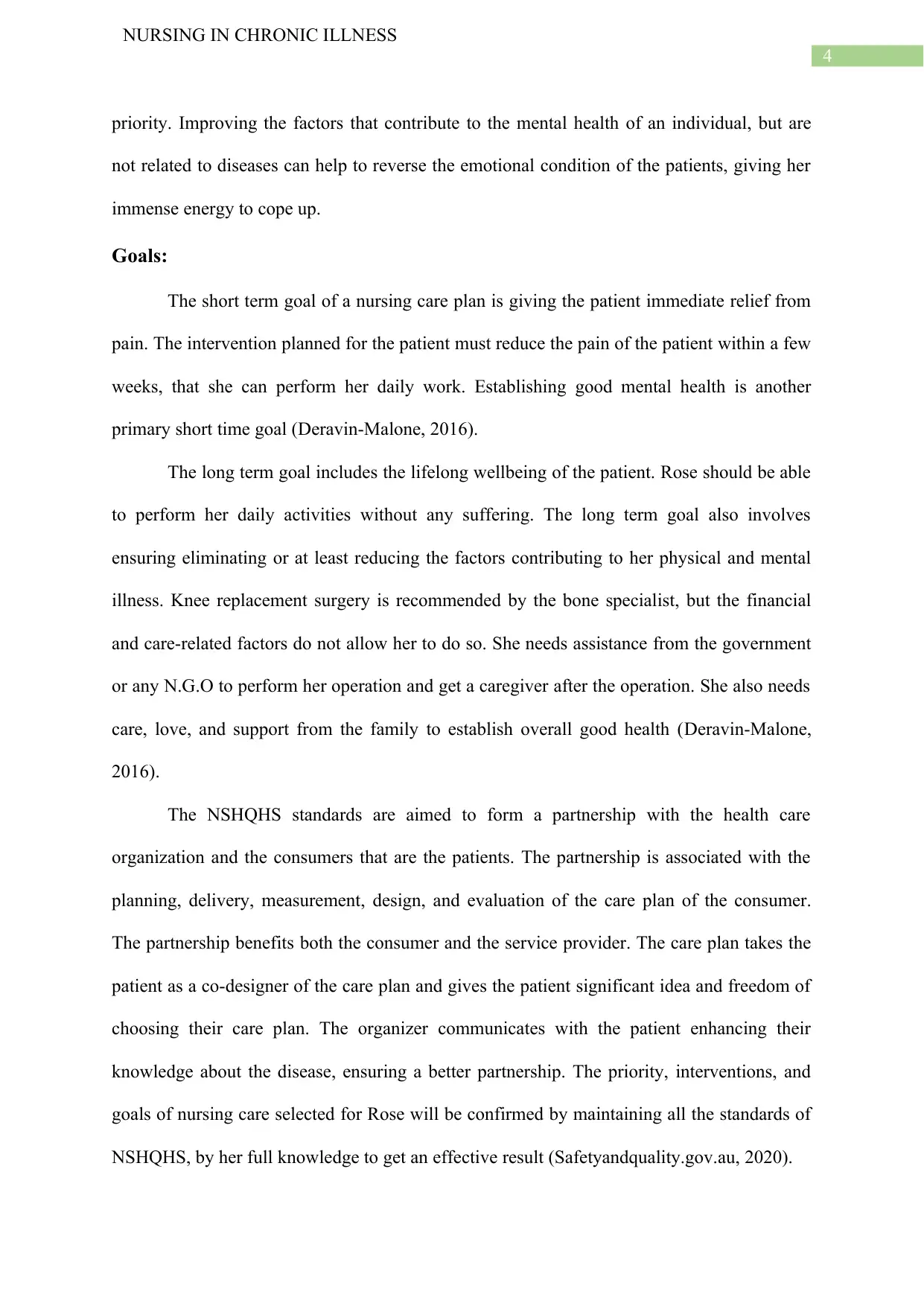
4
NURSING IN CHRONIC ILLNESS
priority. Improving the factors that contribute to the mental health of an individual, but are
not related to diseases can help to reverse the emotional condition of the patients, giving her
immense energy to cope up.
Goals:
The short term goal of a nursing care plan is giving the patient immediate relief from
pain. The intervention planned for the patient must reduce the pain of the patient within a few
weeks, that she can perform her daily work. Establishing good mental health is another
primary short time goal (Deravin-Malone, 2016).
The long term goal includes the lifelong wellbeing of the patient. Rose should be able
to perform her daily activities without any suffering. The long term goal also involves
ensuring eliminating or at least reducing the factors contributing to her physical and mental
illness. Knee replacement surgery is recommended by the bone specialist, but the financial
and care-related factors do not allow her to do so. She needs assistance from the government
or any N.G.O to perform her operation and get a caregiver after the operation. She also needs
care, love, and support from the family to establish overall good health (Deravin-Malone,
2016).
The NSHQHS standards are aimed to form a partnership with the health care
organization and the consumers that are the patients. The partnership is associated with the
planning, delivery, measurement, design, and evaluation of the care plan of the consumer.
The partnership benefits both the consumer and the service provider. The care plan takes the
patient as a co-designer of the care plan and gives the patient significant idea and freedom of
choosing their care plan. The organizer communicates with the patient enhancing their
knowledge about the disease, ensuring a better partnership. The priority, interventions, and
goals of nursing care selected for Rose will be confirmed by maintaining all the standards of
NSHQHS, by her full knowledge to get an effective result (Safetyandquality.gov.au, 2020).
NURSING IN CHRONIC ILLNESS
priority. Improving the factors that contribute to the mental health of an individual, but are
not related to diseases can help to reverse the emotional condition of the patients, giving her
immense energy to cope up.
Goals:
The short term goal of a nursing care plan is giving the patient immediate relief from
pain. The intervention planned for the patient must reduce the pain of the patient within a few
weeks, that she can perform her daily work. Establishing good mental health is another
primary short time goal (Deravin-Malone, 2016).
The long term goal includes the lifelong wellbeing of the patient. Rose should be able
to perform her daily activities without any suffering. The long term goal also involves
ensuring eliminating or at least reducing the factors contributing to her physical and mental
illness. Knee replacement surgery is recommended by the bone specialist, but the financial
and care-related factors do not allow her to do so. She needs assistance from the government
or any N.G.O to perform her operation and get a caregiver after the operation. She also needs
care, love, and support from the family to establish overall good health (Deravin-Malone,
2016).
The NSHQHS standards are aimed to form a partnership with the health care
organization and the consumers that are the patients. The partnership is associated with the
planning, delivery, measurement, design, and evaluation of the care plan of the consumer.
The partnership benefits both the consumer and the service provider. The care plan takes the
patient as a co-designer of the care plan and gives the patient significant idea and freedom of
choosing their care plan. The organizer communicates with the patient enhancing their
knowledge about the disease, ensuring a better partnership. The priority, interventions, and
goals of nursing care selected for Rose will be confirmed by maintaining all the standards of
NSHQHS, by her full knowledge to get an effective result (Safetyandquality.gov.au, 2020).
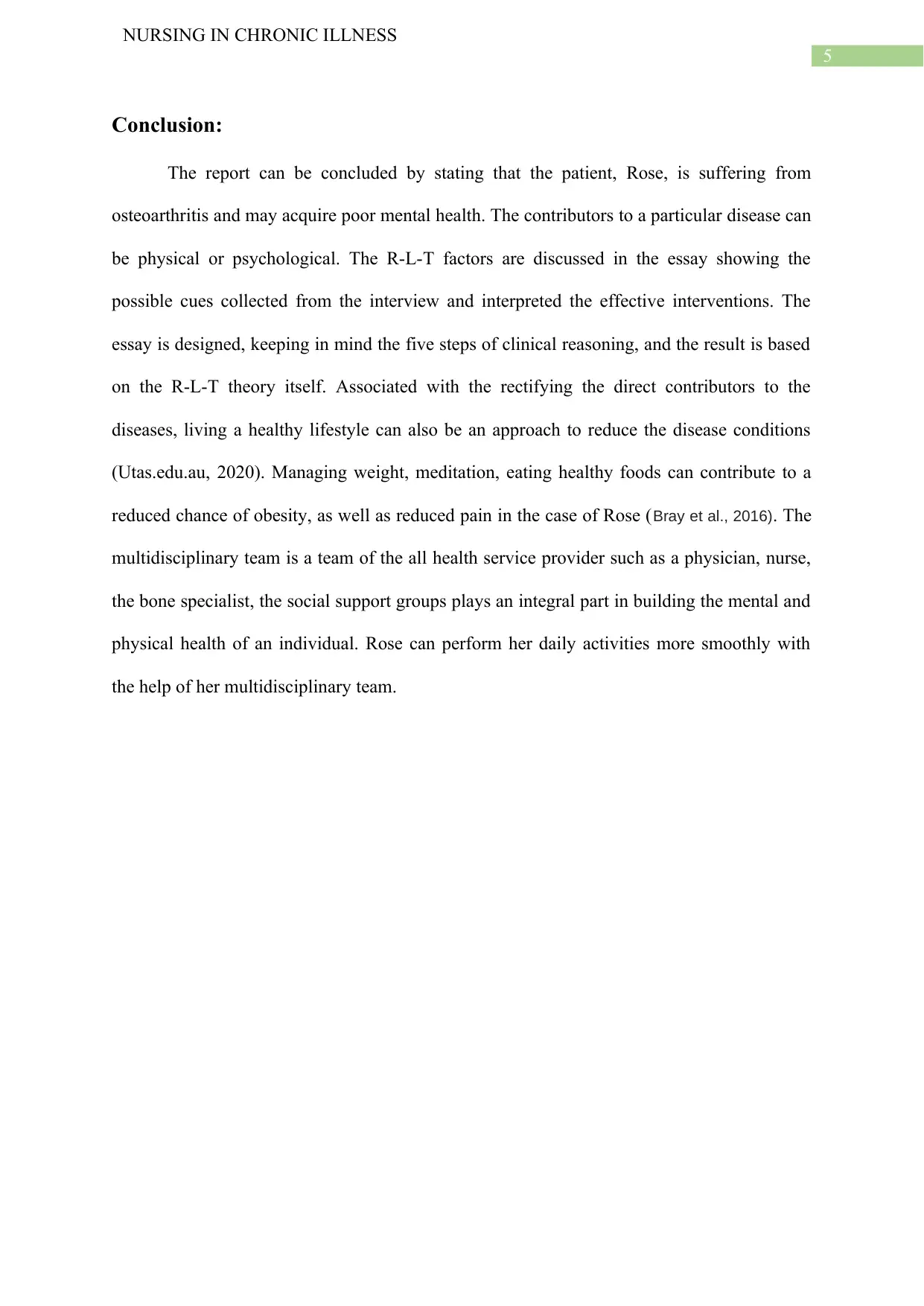
5
NURSING IN CHRONIC ILLNESS
Conclusion:
The report can be concluded by stating that the patient, Rose, is suffering from
osteoarthritis and may acquire poor mental health. The contributors to a particular disease can
be physical or psychological. The R-L-T factors are discussed in the essay showing the
possible cues collected from the interview and interpreted the effective interventions. The
essay is designed, keeping in mind the five steps of clinical reasoning, and the result is based
on the R-L-T theory itself. Associated with the rectifying the direct contributors to the
diseases, living a healthy lifestyle can also be an approach to reduce the disease conditions
(Utas.edu.au, 2020). Managing weight, meditation, eating healthy foods can contribute to a
reduced chance of obesity, as well as reduced pain in the case of Rose (Bray et al., 2016). The
multidisciplinary team is a team of the all health service provider such as a physician, nurse,
the bone specialist, the social support groups plays an integral part in building the mental and
physical health of an individual. Rose can perform her daily activities more smoothly with
the help of her multidisciplinary team.
NURSING IN CHRONIC ILLNESS
Conclusion:
The report can be concluded by stating that the patient, Rose, is suffering from
osteoarthritis and may acquire poor mental health. The contributors to a particular disease can
be physical or psychological. The R-L-T factors are discussed in the essay showing the
possible cues collected from the interview and interpreted the effective interventions. The
essay is designed, keeping in mind the five steps of clinical reasoning, and the result is based
on the R-L-T theory itself. Associated with the rectifying the direct contributors to the
diseases, living a healthy lifestyle can also be an approach to reduce the disease conditions
(Utas.edu.au, 2020). Managing weight, meditation, eating healthy foods can contribute to a
reduced chance of obesity, as well as reduced pain in the case of Rose (Bray et al., 2016). The
multidisciplinary team is a team of the all health service provider such as a physician, nurse,
the bone specialist, the social support groups plays an integral part in building the mental and
physical health of an individual. Rose can perform her daily activities more smoothly with
the help of her multidisciplinary team.
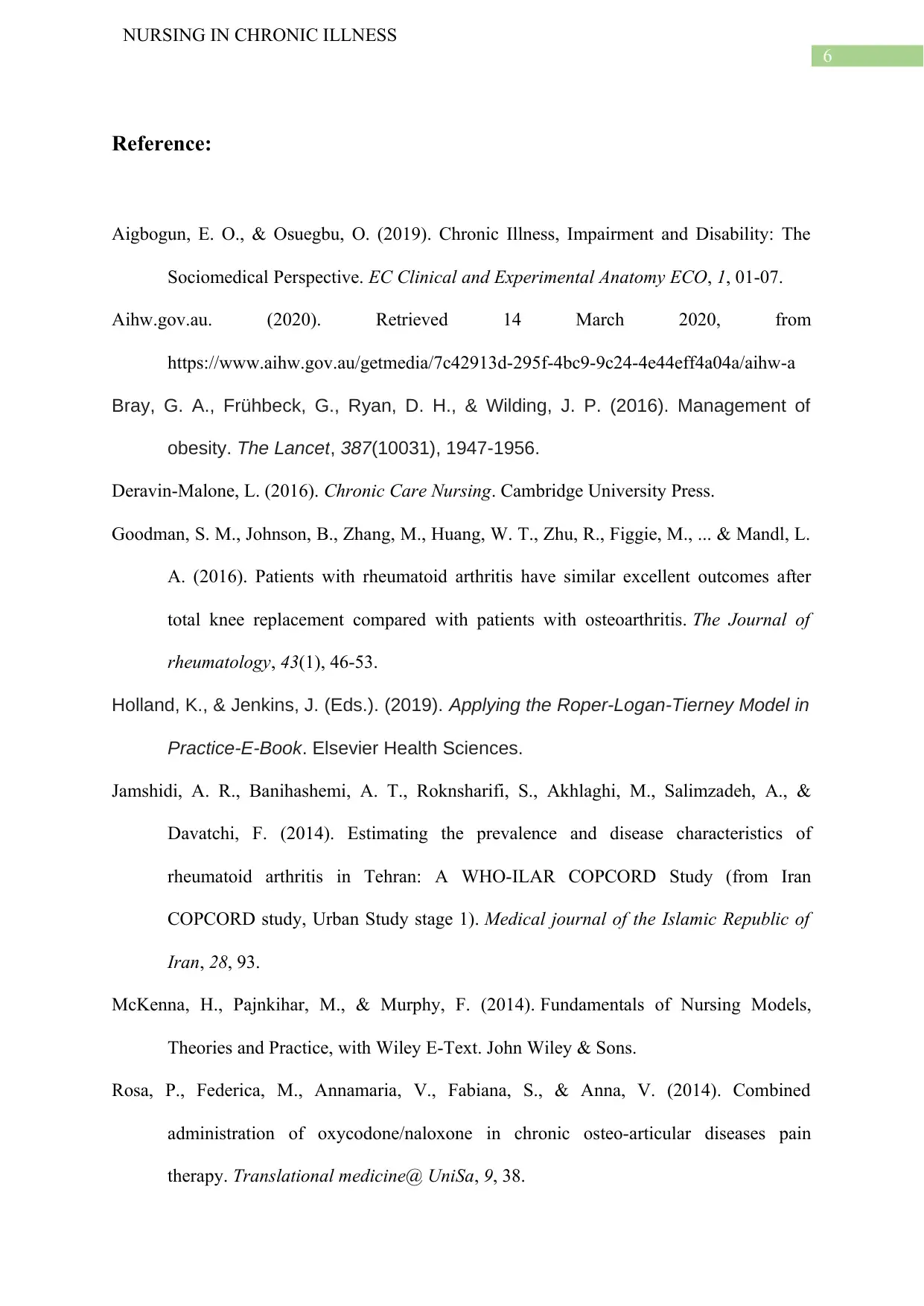
6
NURSING IN CHRONIC ILLNESS
Reference:
Aigbogun, E. O., & Osuegbu, O. (2019). Chronic Illness, Impairment and Disability: The
Sociomedical Perspective. EC Clinical and Experimental Anatomy ECO, 1, 01-07.
Aihw.gov.au. (2020). Retrieved 14 March 2020, from
https://www.aihw.gov.au/getmedia/7c42913d-295f-4bc9-9c24-4e44eff4a04a/aihw-a
Bray, G. A., Frühbeck, G., Ryan, D. H., & Wilding, J. P. (2016). Management of
obesity. The Lancet, 387(10031), 1947-1956.
Deravin-Malone, L. (2016). Chronic Care Nursing. Cambridge University Press.
Goodman, S. M., Johnson, B., Zhang, M., Huang, W. T., Zhu, R., Figgie, M., ... & Mandl, L.
A. (2016). Patients with rheumatoid arthritis have similar excellent outcomes after
total knee replacement compared with patients with osteoarthritis. The Journal of
rheumatology, 43(1), 46-53.
Holland, K., & Jenkins, J. (Eds.). (2019). Applying the Roper-Logan-Tierney Model in
Practice-E-Book. Elsevier Health Sciences.
Jamshidi, A. R., Banihashemi, A. T., Roknsharifi, S., Akhlaghi, M., Salimzadeh, A., &
Davatchi, F. (2014). Estimating the prevalence and disease characteristics of
rheumatoid arthritis in Tehran: A WHO-ILAR COPCORD Study (from Iran
COPCORD study, Urban Study stage 1). Medical journal of the Islamic Republic of
Iran, 28, 93.
McKenna, H., Pajnkihar, M., & Murphy, F. (2014). Fundamentals of Nursing Models,
Theories and Practice, with Wiley E-Text. John Wiley & Sons.
Rosa, P., Federica, M., Annamaria, V., Fabiana, S., & Anna, V. (2014). Combined
administration of oxycodone/naloxone in chronic osteo-articular diseases pain
therapy. Translational medicine@ UniSa, 9, 38.
NURSING IN CHRONIC ILLNESS
Reference:
Aigbogun, E. O., & Osuegbu, O. (2019). Chronic Illness, Impairment and Disability: The
Sociomedical Perspective. EC Clinical and Experimental Anatomy ECO, 1, 01-07.
Aihw.gov.au. (2020). Retrieved 14 March 2020, from
https://www.aihw.gov.au/getmedia/7c42913d-295f-4bc9-9c24-4e44eff4a04a/aihw-a
Bray, G. A., Frühbeck, G., Ryan, D. H., & Wilding, J. P. (2016). Management of
obesity. The Lancet, 387(10031), 1947-1956.
Deravin-Malone, L. (2016). Chronic Care Nursing. Cambridge University Press.
Goodman, S. M., Johnson, B., Zhang, M., Huang, W. T., Zhu, R., Figgie, M., ... & Mandl, L.
A. (2016). Patients with rheumatoid arthritis have similar excellent outcomes after
total knee replacement compared with patients with osteoarthritis. The Journal of
rheumatology, 43(1), 46-53.
Holland, K., & Jenkins, J. (Eds.). (2019). Applying the Roper-Logan-Tierney Model in
Practice-E-Book. Elsevier Health Sciences.
Jamshidi, A. R., Banihashemi, A. T., Roknsharifi, S., Akhlaghi, M., Salimzadeh, A., &
Davatchi, F. (2014). Estimating the prevalence and disease characteristics of
rheumatoid arthritis in Tehran: A WHO-ILAR COPCORD Study (from Iran
COPCORD study, Urban Study stage 1). Medical journal of the Islamic Republic of
Iran, 28, 93.
McKenna, H., Pajnkihar, M., & Murphy, F. (2014). Fundamentals of Nursing Models,
Theories and Practice, with Wiley E-Text. John Wiley & Sons.
Rosa, P., Federica, M., Annamaria, V., Fabiana, S., & Anna, V. (2014). Combined
administration of oxycodone/naloxone in chronic osteo-articular diseases pain
therapy. Translational medicine@ UniSa, 9, 38.
Paraphrase This Document
Need a fresh take? Get an instant paraphrase of this document with our AI Paraphraser
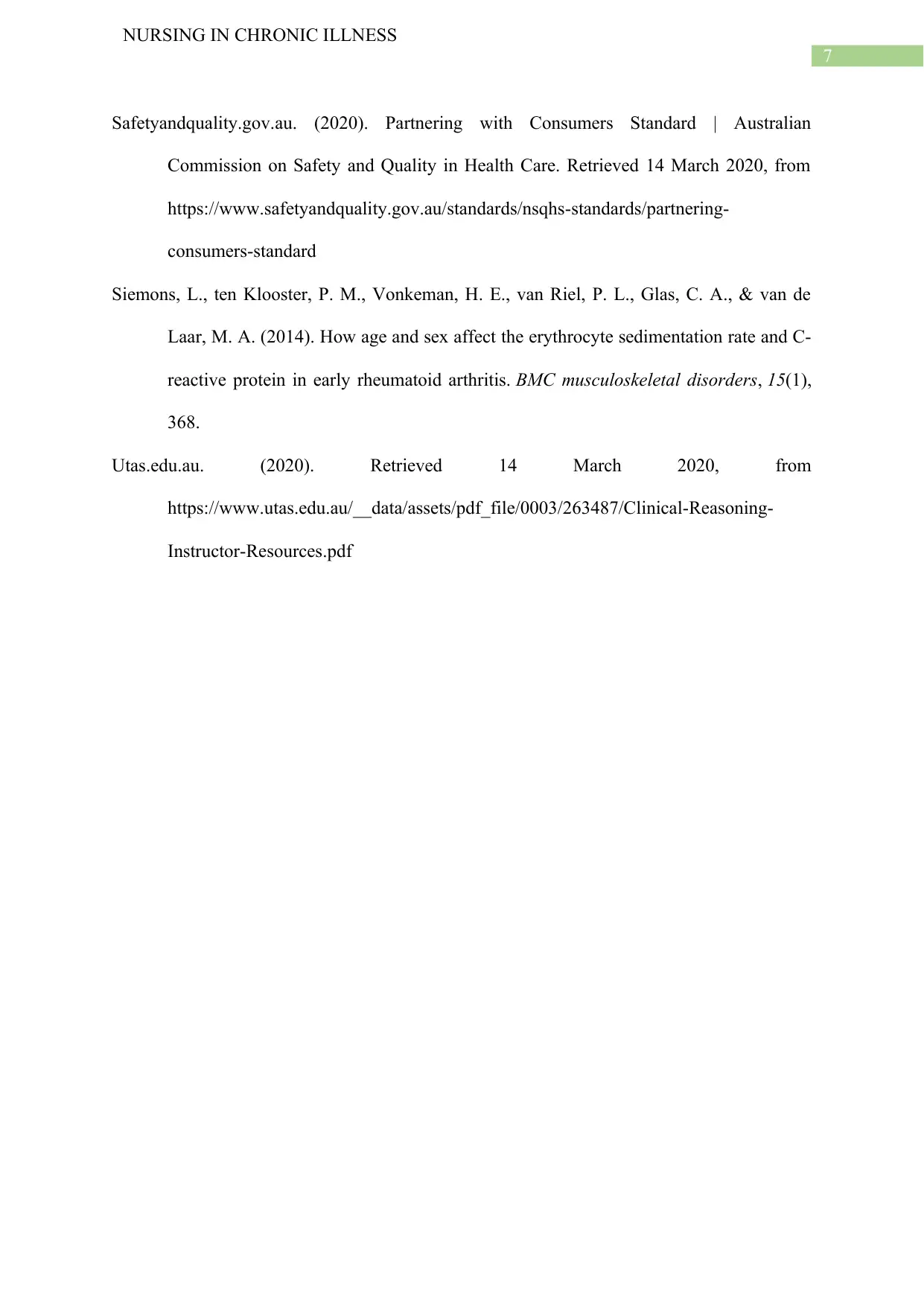
7
NURSING IN CHRONIC ILLNESS
Safetyandquality.gov.au. (2020). Partnering with Consumers Standard | Australian
Commission on Safety and Quality in Health Care. Retrieved 14 March 2020, from
https://www.safetyandquality.gov.au/standards/nsqhs-standards/partnering-
consumers-standard
Siemons, L., ten Klooster, P. M., Vonkeman, H. E., van Riel, P. L., Glas, C. A., & van de
Laar, M. A. (2014). How age and sex affect the erythrocyte sedimentation rate and C-
reactive protein in early rheumatoid arthritis. BMC musculoskeletal disorders, 15(1),
368.
Utas.edu.au. (2020). Retrieved 14 March 2020, from
https://www.utas.edu.au/__data/assets/pdf_file/0003/263487/Clinical-Reasoning-
Instructor-Resources.pdf
NURSING IN CHRONIC ILLNESS
Safetyandquality.gov.au. (2020). Partnering with Consumers Standard | Australian
Commission on Safety and Quality in Health Care. Retrieved 14 March 2020, from
https://www.safetyandquality.gov.au/standards/nsqhs-standards/partnering-
consumers-standard
Siemons, L., ten Klooster, P. M., Vonkeman, H. E., van Riel, P. L., Glas, C. A., & van de
Laar, M. A. (2014). How age and sex affect the erythrocyte sedimentation rate and C-
reactive protein in early rheumatoid arthritis. BMC musculoskeletal disorders, 15(1),
368.
Utas.edu.au. (2020). Retrieved 14 March 2020, from
https://www.utas.edu.au/__data/assets/pdf_file/0003/263487/Clinical-Reasoning-
Instructor-Resources.pdf
1 out of 8
Related Documents
Your All-in-One AI-Powered Toolkit for Academic Success.
+13062052269
info@desklib.com
Available 24*7 on WhatsApp / Email
![[object Object]](/_next/static/media/star-bottom.7253800d.svg)
Unlock your academic potential
© 2024 | Zucol Services PVT LTD | All rights reserved.





